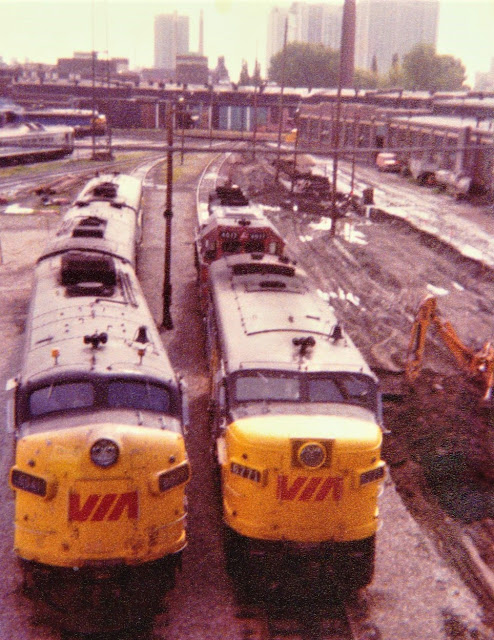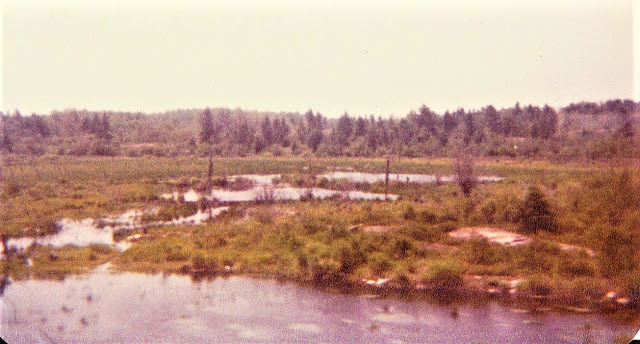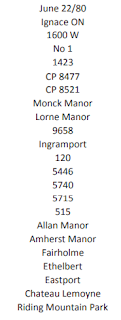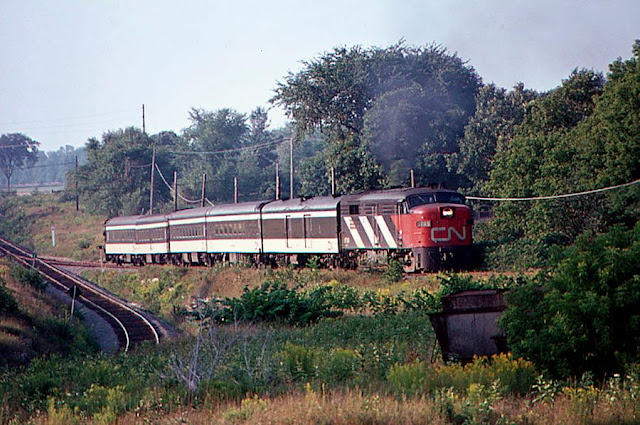
Friday, October 29, 2021
Spadina Roundhouse, June 1980

Friday, October 22, 2021
Kingston-Portage Aboard VIA - June 1980, Part 2

This was the last trip I'd make without taking copious notes. For subsequent trips, I'd prepare a mini-binder ahead of time, in which I'd write the schedule, stations, subdivisions, mileages and leaving room for notes. So much better than trying to read my mind's eye all these decades later!
Here are my notes from the trip, with equipment of different types separated by semi-colons. Freight cars are listed by railway name and/or reporting marks by type: BO (boxcar); HiCBO (Hi-cube boxcar); HO (covered hopper); RE (refrigerator); TA (tank car); FL (flat car); AU (autorack); BU (bulkhead flat car); CO (hopper car); CON (COFC container); TRA (TOFC trailer) etc. Four-digit numbers with or without reporting marks are locomotives.
NOTES - JUNE 22, 1980
Portage waiting for VIA No 3 - CN eastbound at 0647 9514-9572 CNWX, IMCX HO; CGTX, NATX TA; TH&B, TT FL; SR lime BO 46108, L&N BO; cabooses 79860-79560.
Winnipeg - CN switchers 7212, 7217(New orange cab paint scheme), 7157N, 7154N, 7174, 7175; CN cabooses 76568, 76570; CAST, ACL, Dart, HL CON; CNW, BN, IC TRA. Westbound at 0801 CN 4108N-4118-4124 with DRGW, SLSF AU; CANFOR all-door BO, BCR BO and caboose 79511, possibly from BNML interchange. CN 4306N-4314-4323 with caboose 79442. Eastbound with CN 9537-9457-9505-9561 with caboose 79767. VIA 6507-steam generator unit 15453 in CN colours.
Kenora - CP 5523, 4501-4715; van 437020.
Westbound at 1310 - CP 4559-5915, SOO, Milw, Boise Cascade BO; CP GO, CO, BU and van 434588; CP Jordan spreader 402884.
Westbound at 1555 - CP 4726-4702, Japan Line, Seacon CON; E&N 292266 BO; van 434502.
West of Ignace - CP 4729-5587, vans 434571 and 'loose cabooses'' 437188 and 437010.
Ignace - Met VIA No 1 at 1600
Thunder Bay - CP 7081, B-100, 8110, 8127; vans CP 434325, 437171 and 437219 end-cupola; BN, SOO, CNW, Milw, PGE, ONR BO; SOO GO; CP BU; CTI CON. CN 1910N-1914N, 9535; cabooses CN 79711, 76565; ships Frankcliffe Hall, Lake Winnipeg, Scott Misener.
Eastbound at 2050 - CP 5941-5794-4730, CIL HO, E&N 292102 BO and van 434608.
Westbound at 2055 - CP 5922-5513-5509; NYK, TOL CON; Erco HO; TGIX TA; BCE 504 All-door BO; BCH 621 and 634 BO, TH&B GO, van 434110.
Cartier - CP vans 434106, 434558, 434469; CP FL, BO, BU, GO.
Sudbury - CP 8125-8126, 7090; smooth-side CP service cars 21085, 404936, 411713, 411702, 411694.
NOTES - JUNE 23, 1980
Orillia - CN cabooses 79208, 79430, 79604; switcher 1322.
Into Toronto - L&N HO; IC, TPW, SR, RBOX, D&H 20154 BO; cabooses CN 79269, 79378; CN 4497N-4418. CP 6540, 7029, 7026, 8793; YS Line CON; Texas Mexican TRA; CP 437055 end-cupola van.
Spadina - CP 8514, 8517, 8521N; VIA 303 ex-Reading coach; VIA 6786, 6871, 6870, 6611; ONR 1521; CN 9551, 3107, 3114N, 3124N, Tempo 3153.
Oshawa - CN Switchers 1323, 1329, 1317, 1252, 7178, 7179; caboose 79868; EL, PC, CR, GO; MP, CR, Chessie BO; TH&B HO; SP, DT&I, Chessie, CR, UP HiCBO; IG, GT, PC, SSW AU.
Cobourg - SP, SSW HO; CN caboose 79556; CP eastbound 5905-4570-4562.
Belleville - CN 4400, cabooses 79220, 79798.
Though it's taken 41 years, I finally got this trip documented. A paucity of on-train notes led to the trip not even making it into Trackside with VIA - Research & Recollections, unlike all my other trips west aboard VIA Rail!
Running extra...
Kingston's Kingstonist kindly featured my Hanley Spur layout in an online article last Friday. Thanks to journalist Terry Bursey and editor Tori Stafford for reaching out! Now more than ever, this gets my layout 'out of the basement', especially important during a pandemic!
If you ever have reason to doubt GO Transit's testing with C&NW bilevels, this Youtube video will prove it's not just a conspiracy theory.Friday, October 15, 2021
Kingston-Portage Aboard VIA - June, 1980 Part 1
I left Kingston early that morning. Not only would that get me to Toronto ahead of the 1320 departure time and protect the connection, but it would give me some time to explore Toronto. Again, the wisdom of letting a 16 year-old loose on his own in Toronto? Of course the precious time would be spent at the scintillating, sprawling railway lands near the CN/VIA Spadina Shops. Just one day before departure, I had a job interview at the Bath Road McDonald's restaurant. It went well, and I could foresee a career under the Golden Arches. But a conflict arose. Training sessions were being held while I was to be travelling out West. An assessment of my priorities took place. No surprise here, the train trip won! My subsequent summer jobs would not involve the frying and flipping of hamburgers. The same night I wrote, "Can't wait to leave".
Departure from Kingston was aboard the Ontarian at 0700, in window seat 60 in VIA 6115 along with 6002-6351, all in VIA colours. My Dad, brother and sister all turned out trackside to see me off (top photo) before they went off to their day's work. Arrival in Toronto after making seven stops en route, all listed in my well-thumbed (and oddly brown-and-yellow with daffodils publicizing Floralies 1980) April 27, 1980 VIA system timetable. That put our average speed at 52 miles per hour, which is exactly our speed for 6 miles west of Kingston station. The whipping-by of telegraph poles told the true story, with some tangent track travel at over 90 mph! Such speeds were not the case as we passed the Continuous Welded Rail gang on the south track around Mi 185 of the Kingston Sub. I jotted a few notes but saved my film for Spadina.
The cost of the trip? Sample fares listed in the timetable were $14 Basic One-Way Fare Kingston to Toronto; $95 7-30 Day Fare Toronto to Winnipeg; $61 roomette Toronto to Winnipeg. Total fare was $152. Accommodation was $122. VIA's Fare-For-All Plan stipulated that the 7-30 Day Fare was one-way fare plus ONE THIRD (block caps in the timetable!). The Canrailpass was also available, but since the territories were Winnipeg and East, Winnipeg and West and I was getting on and off in Portage la Prairie, I didn't travel with a Canrailpass on this trip.
I put my luggage in coin-operated locker 3297, then spent my few hours in Toronto traversing both sides of the Spadina Avenue bridge. At the time, all manner of VIA, Tempo, CP Rail (Empress of Agincourt on a 30-car westbound transfer!) and GO Transit movements were readily visible. The Turbo and ONR Northlander reposed in the tantalizingly-close coach yard. A three-unit set: VIA 6541-6621-6629 was on the ready track and would power my No 3 north shortly.
This post includes photos and my observations during my morning at Spadina.
After lunch in the station, I boarded 6-6-4 sleeper Green Lane, designated as car 350. Roomette 10 had two shades of yellow walls, a brown window sill, red toilet foot rest with CN hanger and a purple upholstered seat.
Beginning three days prior to my boarding, higher summer travel volumes led to VIA not inter-switching the trains. The westbounds (Canadian No 1, Super Continental No 3) stayed in Sudbury for 80-90 minutes, but dwell time in Sudbury eastbound for both was only five minutes for Canadian No 2 and Super Continental No 4. The other-worldly part of this arrangement is that both full trains ran 20 minutes apart over CP between Sudbury and the outskirts of Winnipeg, where they headed over to the CN station. At least once, waiting in the siding along the way, I can remember the Canadian pulling into a siding behind us for a meet. What a way to run a railway! Bedtime was at 2230 after a long first day, about 20 miles west of Sudbury.
One of the sharper curves along Lake Superior is at Jackfish tunnel:
I was in the vestibule for 16 miles out of Thunder Bay. The eastbound Canadian with ex-CP power pulled in during our stop at Ignace (below). The two trains would normally stop at Ignace 50 minutes apart.
Dinner was a hot roast beef sandwich and raisin pie. Sunset was west of Kenora:
Awesome...on-time arrival of 2050 at Winnipeg. Not so awesome...the 45-minute scheduled servicing stop became a three hour-late departure. My aunt and uncle were real troopers, picking me up at the Portage station at 0200 the next morning!
Here are my notes from the trip, with equipment of different types separated by semi-colons. Freight cars are listed by railway name and/or reporting marks by type: BO (boxcar); HiCBO (Hi-cube boxcar); HO (covered hopper); RE (refrigerator); TA (tank car); FL (flat car); AU (autorack); BU (bulkhead flat car); CO (hopper car); CON (COFC container); TRA (TOFC trailer) etc. Four-digit numbers with or without reporting marks are locomotives.
NOTES - JUNE 11, 1980
Mi. 184 Kingston Sub - CWR gang on south track, track machines spike puller 483-15, 672-64, 672-65, 672-66, 672-60, 685-3, 685-21, 141-72, 141-73, 165-13, 193-14, 193-00. The RCO is next to us on the south track, and the crew has halted their work (above).
Eastbound led by CN 5034, Procor TA.
Napanee - SR 114200, TT 82156 BU.
Belleville - CN crane 50473; caboose 79577; SR BO; Domtar and Canadian Liquid Air TA; CN 9411, 4536(New orange cab paint scheme), 3118N.
Cobourg - BCH 622 and CP BO.
Oshawa - CN switchers 7178, 7179, 1256, 1326N; cabooses 79867, 79868; EL, CN, GT, SP, SF, CR, SSW AU; GT, SR, NW, UP, HiCBO; PC, SSW, Chessie B&O, C&O BO.
Don Yard? - Jeffrey Mine Asbestos Quebec HO; CN switchers 1244N, 1237, 8235, 8181, 1240N; caboose 76561; GO 507-2024.
Toronto Spadina - GO 907-1007-1068-9559-1093-9969-9366-702, 706, 506, 904; CN Tempo 3152-3154, 8519N, 8518, 8517, 8232N, 8236, 8514, 8516N, 3117N, 4574-3649-3115, 4016, 4017; cabooses 79715, 79491, 79613; VIA 6541-6621-6529, 6771, 6625, 6637, 6763-6859, 6869, 6858, 6771, 15302, 6623, steam generator 15456V (in VIA paint); VIA RDC's 6204-6005-6101, 6106, 6114V, 6209V, 6104; CP 8921, 8785-8798-8769, 8142, 6529, 7063; CP business car Mount Stephen; CP vans 437482, 437238, 437270, 437138 end-cupola, 434420, 434124; CP Jordan spreader 402891; Tempo train 3150-321-340-368-363-376 and 365-370-341-323; ONR 1508; six steam generator units - 3 each in CN and VIA paint.
Toronto eastbound at 1035: CN 2307N-2334N-2555 with NSR 432, UP, Chessie BO; NW, CR, LV 50947, Sclair, PC, NW TWGX HO; Bay Line 7186 BO.
Leaving Toronto - CP switchers 6537 (CP Rail scheme) and 6538 (script scheme):
Orillia? - CN cabooses 78781 end-cupola, 79587, 79208; BCR BU; 4524N; CN 70792 MoW baggage car.
Eastbound at 1633: CN 9631-5507 with CN TRA, FL, BO and caboose 79785; CN 5528-9628.
Sudbury - CP 8125 with end-cupola van 434027; CP 5003, 7090, 4511, 4553, 4714; vans 434037, 434009, 434030, 434596; CP business car Ontario.
NOTES - JUNE 12, 1980
Marathon - Eastbound CP 4224-5024, Chessie-B&O, SOO, MP, NW, PC, P&LE, EJ&E, Alaska RR, LM ?BO; IC GO; with van 434317. CP 5745-5715-5795-5540, 4562-4726-4563; ACR GO; Sperry Car 147.
Eastbound at 1105: CP 5511-5504-5670 with CP GO, BO, RE and van 434463.
Thunder Bay - CN 1900, 1906N, 1378N, 1377; CN caboose 76565, CN Jordan spreader 50943; CP 8619, 8166, 8128, 4721, 4572, 5595, 5688, 7062, 5948, 6598, 6580, 5628, 8708; CP vans 434513, 434605; PGE, BCR, GN, UP, Milw, SOO, CNW BO; ACR, BN, TH&B, EJ&E 84024 GO; GT FL; CTI, CP CON; PTLX, NAHX, Canadian Wheat Board, CNWX, CPWX HO; CP auxiliary crane 414473 with boom car 421300, CP Service cars with clerestory roofs 411753, 411700 and 411736 (smooth side); ship at anchor Canada Steamship Lines Baie St-Paul.
Eastbound CP 5608-5586-5646-4718 with CP FL, van 434508 (below); CP 4715, 5531.
Near Ignace - met eastbound VIA No 2 at 1804
CP 5930-5527-5571 and van 434614.
Dryden - CP Service cars 411730-411732 (smooth side) and 411750; CP 6555.
Kenora - CP snowplows 400798-400799; MDW BO; CP 6547; CP end-cupola van 437020.
Winnipeg at 2343 - Eastbound CN 1353-4129-4276-1371 with NW AU; CNW TRA and caboose 79265 possibly from BNML interchange ; Westbound CN 9581-9527-9540 with BCR BU; SR TRA; Cast, APL and ML CON; caboose 79524.
CN 1370N, 7224N.
Eastbound at 2327 - CN 4224-caboose 79704; CN 5144-5218 and caboose 79631.
NOTES - JUNE 13, 1980
Westbound at 0041 - CN 5205-5024 with orange ballast cars and caboose 79801.
Of the next nine days, four were all-day trainwatching. That means 8 a.m. to 5 p.m., the same as my uncle's dental office hours, with 90 minutes for lunch. I observed between 13 and 17 trains per day.
(In Part 2, join me for the return trip aboard VIA No 4.)
Running extra...
Eric Clegg's railway memorabilia website is live! Check out Memorailia for rare original CN items, books, art, souvenirs and timetables:
After undergoing two organ transplants, with the last one lasting 20 years so far and likely decades of service to come, I decided to become less organ-ized Thanksgiving Sunday. I hung up the keys, and took my foot off the pedal. I wish my successor all the best (hymn or her). This photo, taken by my good wife, seemed to suit the occasion. The sign was changed from its previous iteration, "This Sunday's sermon "'What is Hell?' Come early and listen to our choir practice!"



































































